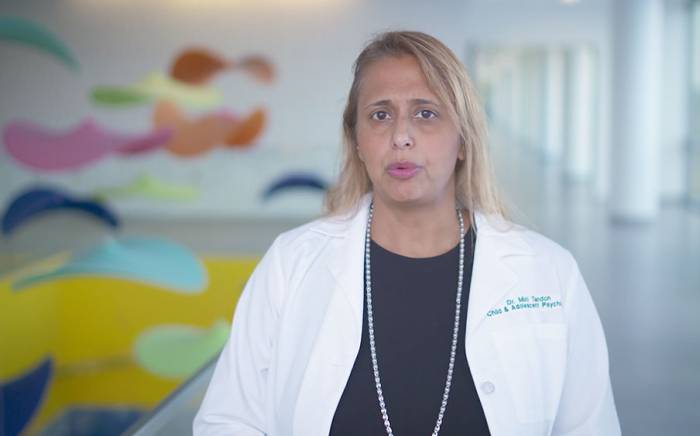 St. Louis Children's Hospital is proud to be a Children's Miracle Network affiliated hospital.
St. Louis Children's Hospital is proud to be a Children's Miracle Network affiliated hospital.
Every dollar raised by Children's Miracle Network (CMN) of Greater St. Louis, through the generous contributions and support of individuals, as well as local and national sponsors, helps Children's Hospital acquire programs, equipment and facility renovations to meet the needs of area kids.
Since its inception in St. Louis in 1988, CMN has donated more than $50 million to St. Louis Children's Hospital and SSM Health Cardinal Glennon Children's Hospital.
Visit www.cmn-stl.org for more information!
Read more about our 2025 CMN Patient Ambassadors below!
Meet Jordan
Diedre can't suppress her smile when she talks about her son. Jordan, a 10-year-old basketball fan, has always been a source of happiness for his family and people around him. His smile and sweet spirit rub off on anyone he meets. Jordan loves to do things that most pre-teen boys like, such as basketball, playing Fortnite, playing chess and hanging out with his brothers. One of the things that makes Jordan unique is that he has been living with the pain and complications of sickle cell disease — a serious and lifelong disorder that causes his body to make sickle-shaped red blood cells that are sticky and stiff. For children with sickle cell disease, blood flow becomes blocked in the blood vessels and causes pain, infection and organ damage.
When Jordan was born, he had a severe case of jaundice, and his medical team alerted his parents immediately that it could be caused by sickle cell disease. His family was aware of a genetic component and that the risk existed, but their family was still surprised when Jordan was diagnosed with hemoglobin SS, the most severe form of the disease. Shortly after his birth, Jordan's grandparents retired from their jobs to help with his care to prevent him from attending daycare. His mom emphasized that keeping Jordan healthy became a family affair. For Jordan, the slightest illness, even if not sickle cell disease-related, usually meant he was admitted to the hospital. As Jordan has gotten bigger and stronger, these hospital stays have become less frequent. When Jordan turned 2, he began taking medication to help manage his disease. While the medication seems to keep him healthy, many side effects must be monitored so his care team at St. Louis Children’s Hospital continues to see him every three months. When Jordan turns 12, he will become eligible for a research trial using medication to try to cure sickle cell disease, and Jordan’s family is hopeful for continued research in this area.
In the meantime, Jordan continues to excel in school and plans to learn how to play golf. His family is trying to keep him as healthy as possible so he can continue to play basketball and pursue his dream of becoming a professional basketball player. According to Jordan, if that career path doesn’t work out then he will consider becoming a doctor.
How CMN Funds Help Jordan and Kids Like Him:
Jordan's mom, Diedre, is thankful for the funds raised by CMN that provide support from Child Life Services to keep him comfortable while in the hospital. Jordan was also very excited to attend Camp Crescent, a donor-funded camp for children with sickle cell disease, this past summer where he had the opportunity for the first time to meet other kids who share the same diagnosis. Jordan embraced the experience, met a ton of new friends and can’t wait to return next summer.
Meet Lilly
Lilly has a lot of favorite pastimes. As a busy 6-year-old, she loves to do art projects, play soccer, take hip- hop dance classes, play basketball and the list goes on. Her parents say that she is very social, which means she has made many new friends in kindergarten. Lilly is also living with achondroplasia, a bone growth disorder that results in dwarfism. But Lilly has no plans to let her diagnosis slow her down.
According to her mom, Morgan, Lilly's birth was uneventful and noted that nothing about her diagnosis was detected prior to when she was born. At a few hours old, Lilly's newborn screening showed several concerning markers, including a larger head circumference and trident fingers. A few days later, Lilly's parents met with St. Louis Children's and a WashU Medicine neurosurgeon.
While the first four months of Lilly's life were pretty typical, she soon began to develop medical complications that made her extremely uncomfortable. Lilly's symptoms became so severe she arrived at St. Louis Children's and underwent emergency surgery to place a shunt in her brain. This was the start of Lilly's more complex medical journey.
Since then, Lilly has required additional surgeries to battle her compressed and narrow foramen magnum — the opening in the skull that connects the spinal cord and brain — that becomes narrow and compressed and restricts spinal fluid in those with achondroplasia. This causes many issues such as debilitating migraines and Lilly also struggles with severe obstructive sleep apnea due to her small bone structure. Lilly doesn't feel good often and her parents are always trying to figure out if it is related to the shunt in her brain, low blood sugar, spinal fluid compression or something else. Lilly was struggling with nausea and vomiting regularly and the endocrinology team at St. Louis Children's discovered that her blood sugar was getting so low she was becoming ill. While she is not diabetic, she now wears a continuous glucose monitor so her blood sugar can constantly be observed. This is to prevent her levels from dropping too low. Lilly's medical team believes that due to her achondroplasia, she burns through her energy storage three times faster than an average height 6-year-old. Lilly is also monitored by Orthopedics every year to track her spine and bone growth.
Lilly's parents are very grateful for the care received at St. Louis Children's Hospital. In just six short years, Lilly has been through eight surgeries, 15 MRIs, seven sleep studies and more scans, appointments and IVs than they can count. Understandably, Lilly has a lot of fear and anxiety when it comes to being at the hospital, but her parents insist on how instrumental her excellent care has been in getting Lilly to this point in her life. Lilly's parents are involved in many Little People of America (LPA) groups all around the world and they can attest that the care Lilly receives at St. Louis Children's is world-class. They are thankful to have such a great medical team in their hometown.
How CMN Funds Help Lilly and Kids Like Her:
Because of support from CMN, Lilly's parents have felt supported at St. Louis Children's Hospital and are thankful for the many specialists and services provided during their hospital visits. With Lilly's condition, even routine visits that involve anesthesia require an overnight stay. Donor-funded resources such as Child Life Services and the Center for Families provide support for Lilly and her family, especially since these visits create a lot of anxiety for her. Every single part of Lilly's body is affected by her diagnosis and yet, because of her excellent care that is supported by generous donations, she doesn't let her size deter her from doing the things she loves.







